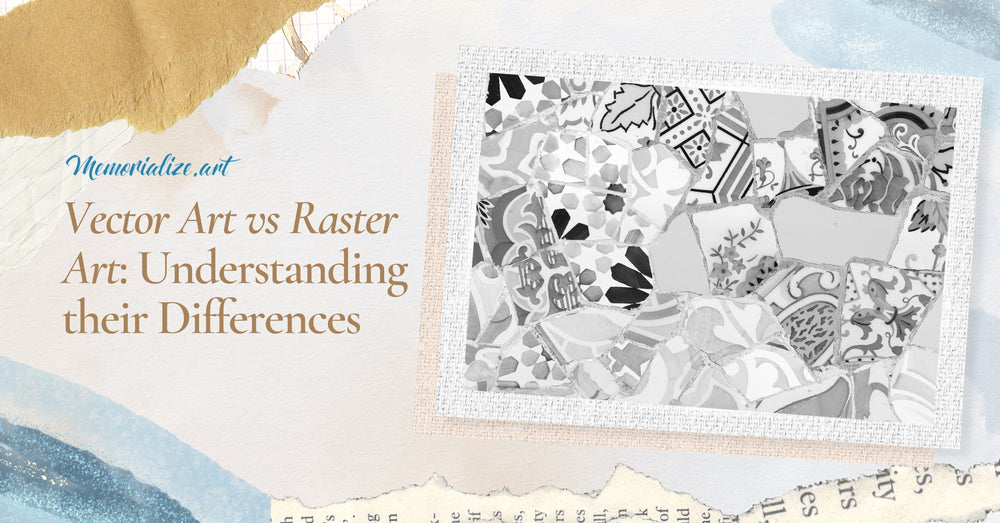Vector Art vs Raster Art: Understanding their Differences

Vector art and Raster Art are two of the most well-known types of digital artwork today. A designer who is aware of the difference between vector art vs. raster art will be in a better position to choose the most appropriate one for any particular project.
Vector Art, which consists of points and lines, looks great no matter how big or little you make it. Creating and editing new shapes is made easier by the fact that points and lines may be freely changed. In contrast, Raster Art created with pixels works well for complex effects like gradients and textured surfaces. It works well for images and other graphics with a lot of fine detail.
Still, which is better for an artist just starting out in the field of digital painting: vector art vs. raster art?

What is Vector Art?

Vector art is a kind of computer graphic that relies on geometrical elements like points, lines, and curves. This kind of artwork may be magnified or shrunk in size without compromising its overall quality.
Definition and Explanation
Vector art is a sort of digital artwork in which pictures are made using mathematical techniques. Vector graphics are made up of pathways, which have a start and end point as well as additional points, curves, and angles along the route.
Vector art is often done using vector editing software like Adobe Illustrator, Inkscape, and CorelDraw. Vector art is popular in print and online design because it can be scaled without sacrificing resolution quality.
Advantages and Disadvantages of Vector Art
Advantages:
- Vector images are resolution-independent, which means they may be stretched to any size without sacrificing artwork quality.
- Vector art is less difficult to alter than pixel art.
- Vector art may be utilized to quickly and easily produce sophisticated and elaborate designs.
Disadvantages
- Vector art should not be used to create very realistic visuals.
- It might be tough to transfer vector graphics to other formats.
- Color blending and shading are difficult.
Common Uses
-
Logo Design
-
Typography
-
Digital Illustrations
-
Web Design
-
Animation
What is Raster Art?

Definition and Explanation
Raster graphics is a kind of computer artwork that creates pictures by combining many small color squares. A digital picture is composed of very tiny squares, called pixels, organized in a grid. Adobe Photoshop, Corel Painter, and other raster graphics editors, as well as vector graphics editors like Adobe Illustrator and Inkscape, are used to produce raster artwork.
Using raster art, it's easy to make realistic pictures with a lot of depth and clarity. The fine features and delicate color transitions in pictures and other images make them ideal candidates. Raster artwork benefits from a grid of pixels that allows it to be resized without compromising quality.
Advantages and Disadvantages of Raster Art
Advantages
- It is simpler to make intricate artwork using a raster-based application since it utilizes pixels to form an image.
- It can be used to make drawings, pictures, and artwork with a more natural, realistic appearance.
- Raster art can be easily resized without losing its quality.
Disadvantages:
- Raster art is not suited for making artwork with precise, crisp lines since it might become pixelated when expanded.
- Raster art may be challenging to manage and change if a certain degree of intricacy is attained.
- Raster art is not great for reusing artwork since it might become distorted or pixelated when scaled.
Common Uses
-
Raster art is often employed in digital photography because it can capture a broad variety of colors and tones.
-
Raster art may be used to create print graphics such as brochures, flyers, and posters.
-
Raster art is often utilized to produce complex 3D graphics of characters and locations.
Comparison between Vector and Raster Art
When compared to raster images, vector artwork maintains its quality regardless of the size at which it is displayed. Therefore, logos, charts, and diagrams are the ideal applications for vector art while raster art is ideal for artworks like photographs, graphics, and paintings that feature a broad variety of hues and shades. Comparatively, vector art consumes less storage space on a computer or device than raster art does.
Importance of choosing the right type of art for specific situations
It is important to choose the right type of art based on specific situations. Selecting the correct kind of art may assist in setting the tone for a project. It is crucial to every design project to choose the appropriate form of artwork for its intended use.
When deciding between vector and raster art, there is no definitive winner. They're both fantastic ways to express your artistic side, so choose whichever one suits you most! Memorialize Art is your one-stop shop for exceptional works of art. Services such as vector painting and raster painting are just two examples of how we cater to our client's preferences. Check our collection now and pick your wager.










